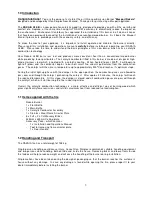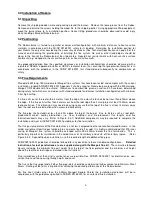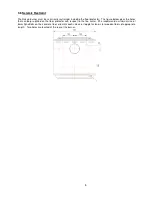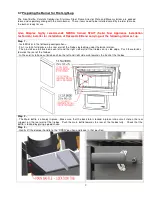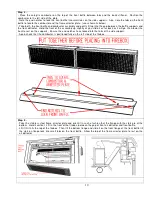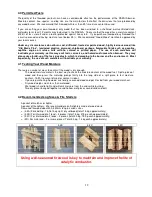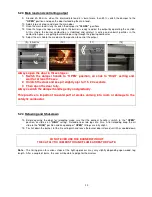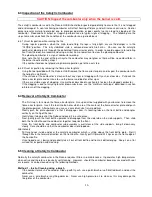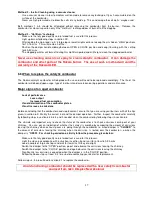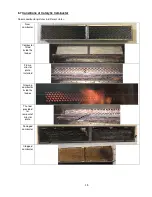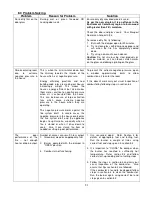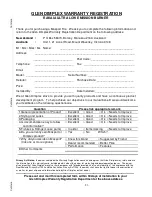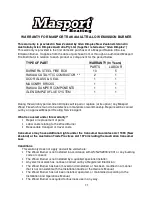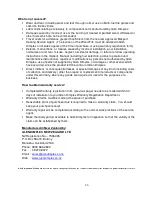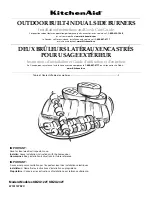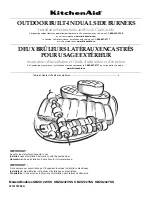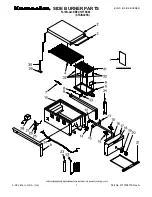
16
6.3 Inspection of the Catalytic Combustor
CAUTION: Inspect the combustor only when the burner is cold.
The catalytic combustor used in the Rakaia ULEB should be inspected periodically to ensure that it is not clogged
and or damaged. A non-functioning combustor will affect heating efficiency and will increase emissions. Soot or
darker granular material generated due to improper operation or poor quality fuel can lead to clogging of the
combustor. Reduced heat output or sluggish performance are typical signs of clogging. The following are the
steps to monitor and check the condition of the combustor on a periodic basis:
6.3.1 Visual Inspection while running the fire
-
During regular operation, when the main load of big fire logs is fully alight, ensure the damper is in the
“CLOSE” position. This fully stabilized state is achieved around 40~60 mins. You can see the catalytic
combustor glowing parts through the perforated flame arrestor plate. In order to avoid exposure to radiating
heat from the door, we recommend using a mirror from a lower level to view the glowing combustor.
-
The glowing combustor is a sign of combustor working.
-
Also, note that at the end of the burn cycle the combustor may not glow as there will be no combustibles in
the burner to activate the catalyst.
-
If the combustor does not glow during normal operation go to the next step
6.3.2 Visual inspection by removing the flame arrestor plate
-
Using the tool provided with the Rakaia ULEB remove the flame arrestor plate and inspect the combustor with
the help of a small torch.
-
If the surface of the combustor is clean without any signs of clogging with fly ash or creosotes. Put back the
flame arrestor plate and continue to use the burner and look for other signs.
-
If there are visible signs of clogging, Use methods described in section 6.4 to clean the clogged combustor.
-
If the clogging is due to tarry or granular brown substance, use the “Hot Burn technique” described in section
6.5 to burn off the clogging.
6.4 Removal of Catalytic Combustor
-
The first step is to remove the flame arrestor plate. Use special tool supplied with your burner to remove the
flame arrestor plate. Insert the tool into the holes which are at the center of the flame arrestor plate and push
the plate upwards. Alternatively, you can use a medium-size flat screwdriver.
-
Slowly push the plate upwards so that it disengages from it’s locating tabs on the front baffle and dangles
vertically on the tip of the tool.
-
Gently take it down out of the firebox and keep it in a safe place.
-
Next, gently push the front baffle upwards to disengage from the side tab on the side supports. Then slide
both the front baffle and the combustor together towards the front.
-
Once this front baffle and combustor sub-assembly is well clear of the side supports, bring it down very
slowly. Care should be so that the combustor does not dropdown.
Alternatively
-
Put two hands inside and over the catalytic combustor which is sitting above the front baffle plate. Roll it
through 90
0
in the forward direction on the front baffle. Gently pull it forward till it tips oven the front edge of
the front baffle.
-
Once tipped over, slowly and gradually take it out of front baffle and front air deflector gap. Keep it on a flat
surface for inspection and cleaning.
6.5 Cleaning of Catalytic Combustor
Normally the catalytic combustor in the Rakaia requires little or no maintenance. It generates high temperatures
when active and therefore is basically self-cleaning. However, should the combustor becomes covered with soot
or creosote, it can be cleaned using the following methods.
Method 1 – In-situ Cleaning using a brush
-
If the combustor mesh is covered or filled up with fly-ash, use a paint-brush or soft-bristled brush and dust the
combustor.
-
Never use a wire brush or anything abrasive. Never use high-pressure air to clean as this may damage the
fine plates of the combustor.
Summary of Contents for RAKAIA
Page 24: ...24 ...


